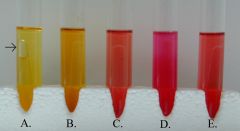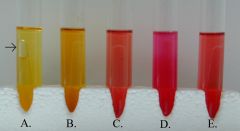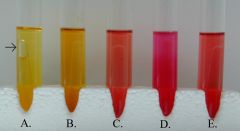![]()
![]()
![]()
Use LEFT and RIGHT arrow keys to navigate between flashcards;
Use UP and DOWN arrow keys to flip the card;
H to show hint;
A reads text to speech;
23 Cards in this Set
- Front
- Back
|
carbohydrates |
the most common energy source for microorganisms |
|
|
chemoheterotrophic organisms |
obtain energy from 2 basic processes:
Both catabolic systems convert the chemical energy of organic molecules to high-energy bonds in ATP |
|
|
What are the 3 pathways that can produce energy during respiration? |
|
|
|
How does respiration differ from fermentation? |
|
|
|
aerobic respiration |
when molecular oxygen is the terminal electron acceptor |
|
|
anaerobic respiration |
when an inorganic molecule serves as the external terminal electron acceptor and becomes reduced
ex: nitrate (NO₃⁻) or sulfate (SO₄²⁻) |
|
|
fermentation |
|
|
|
carbohydrate fermentation |
includes the hydrolysis of disaccharides prior to the fermentation reaction
fermentation begins with the production of the intermediate compound pyruvate |
|
|
lactose fermenter |
an organism that is able to synthesize the enzyme β-galactosidase which splits lactose into the monosaccharides glucose + galactose |
|
|
Biooxidative pathways using glucose as a substrate |
Glucose is catabolized during glycoloysis (E-M pathway) > 2 Pyruvic acid + 2 NADH + 2 ATP
The pyruvic acid is used in one of 3 pathways:
|
|
|
fermentation tube |
used to determine if a bacterium is able to ferment a particular CHO
it contains:
|
|
|
Durham tube |
inverted tube inserted into PRB media of the fermentation tube
used to test for gas production during fermentation; you DO NOT know what type of gas was produced |
|
|
Phenol Broth Red (PRB) |
fermentation media containing a specific CHO (glucose, sucrose, or lactose)
base media contains:
|
|
|
Phenol Red |
pH indicator used in PRB media yellow = acidic pH below 6.8 red = in between pink = alkaline pH above 7.4 |
|
|
What does a color change of medium yellow in PRB media indicate? |
|
|
|
What does a color change of medium pink in PRB media indicate? |
|
|

Describe the results of the PRB result in Tube A |
medium yellow = positive for acid production some turbidity gas was produced fermentation of CHO occurred
|
|

Describe the results of the PRB result in Tube B |
medium yellow = positive for acid production some turbidity NO gas was produced fermentation of CHO occurred |
|

Describe the results of the PRB result in Tube C |
uninoculated control |
|

Describe the results of the PRB result in Tube D |
pink = acid production may have occured alkaline byproducts > CHO was consumed; peptones were catabolized to amino acids > NH₃ some turbidity NO gas was produced fermentation of CHO occurred * this result can occur if the culture is incubated for more than 48 hrs and the CHO are used up |
|

Describe the results of the PRB result in Tube E |
medium pink = alkaline reaction peptones were catabolized to amino acids > NH₃ some turbidity NO gas was produced NO fermentation of CHO occurred |
|
|
What will happen if a PRB tube that undergoes CHO fermentation is incubated for more than 48 hours? |
The result may be a false negative for acid production. I may be pink as a result of alkaline (basic) byproducts, from peptone catabolism, that were produced AFTER ALL of the CHO was consumed |
|
|
What species of bacteria were used in this experiment? |
|

